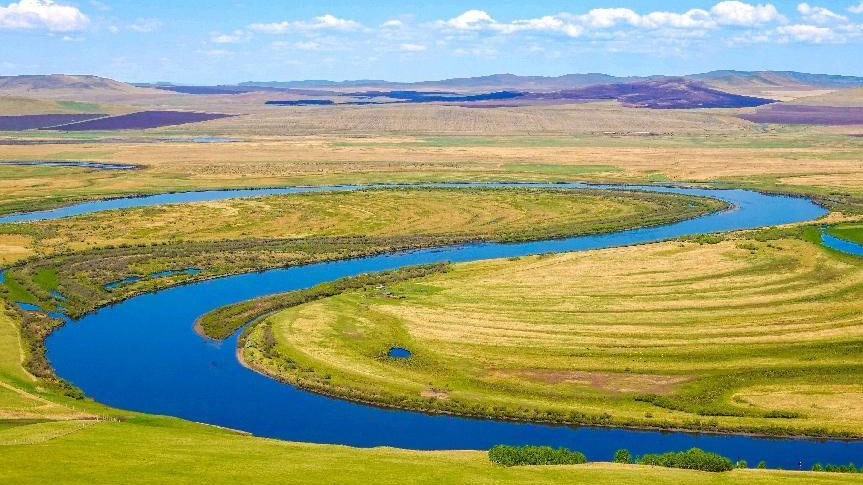Wine industry grows hope, dreams out of waste quarries

This aerial photo taken on June 5, 2023 shows a winery at the foot of Helan Mountain in northwest China's Ningxia Hui Autonomous Region. (Xinhua/Feng Kaihua)
YINCHUAN, June 11 (Xinhua) -- If not for the stones scattered between the lines of wine grapes, not easily would one believe that the vast green area stretching along the eastern foot of Ningxia's Helan Mountain was once an abandoned quarry.
After trimming extra buds from the vines for a while, Su Jinping straightened her back for a break. "I feel quite refreshed and ineffably satisfied," said Su, 51, from Yuanshi winery in Haoyuan Village of Yinchuan, capital of northwest China's Ningxia Hui Autonomous Region, as she eyed the vast green scene.
As a natural barrier to protect the Ningxia plain from the threat of the neighbouring Tengger Desert, the Helan Mountain area, however, was ecologically damaged since the 1950s by efforts to exploit its abundant coal and other mineral resources, leaving wasted quarries and mine pits as scars on the mountain.
Thanks to an ecological restoration and protection campaign led by the local government, coal and other mines were shut down. With its eastern foothills found to have an ideal climate for growing wine grapes and producing world-class wines, Helan Mountain was able to usher in a green revival, attracting more than 200 wineries, including Yuanshi winery, to settle down in the region over the years.
Yuanshi winery is located on what was once a waste quarry pit. After mining good wealth at the foot of Helan Mountain, Yuan Hui, the first owner of the winery, decided to return the favor to nature by planting trees and developing a wine industry upon the site of the waste quarry at the turn of this century.

This aerial photo taken on June 8, 2023 shows wineries and wine grape planting bases at the foot of Helan Mountain in northwest China's Ningxia Hui Autonomous Region. (Xinhua/Wang Peng)
Su, one of the original workers in the winery, still remembers the scenes when she first came to the site 20 years ago. "The stones scattered everywhere, and the sands would grind my teeth every time there was a wind. I worried more than once whether the tender grape seedlings could survive," she said.
The seedlings turned out to be stronger than Su had thought. So far, a total of 6,000 mu (400 hectares) of mining areas has been restored and treated, by planting 8,000 mu of windbreak forest, 1,000 mu of fruit trees, and 3,000 mu of wine grapes, totaling more than 3 million plants of all kinds.
"We turned the mine pits into a cellar and ponds, and replaced the quarry site with forest, an eco-park open for free and a large intelligent vineyard growing 16 kinds of wine grapes. This has greatly improved the local microclimate and living environment," said Yuan Yuan, Yuan Hui's daughter, who took the "relay baton" after graduation.
According to the 31-year-old winery owner, the concept of eco-environment protection can be seen everywhere, and especially in the winery architecture. Rocks and stones from the quarry were used to build walls, while waste wood and vines from the vineyard were used to construct roofs.
"We try to make the best use of such waste materials, and it works well. For example, the thick stone wall enables the cellar to keep cool in summer and warm in winter," Yuan added.

This aerial photo taken on May 13, 2023 shows a park transformed from a mining subsidence area at the foot of the Helan Mountain in Yinchuan, northwest China's Ningxia Hui Autonomous Region. (Xinhua/Feng Kaihua)
Yuanshi winery is just an epitome. To protect and restore the ecology of Helan Mountain, Ningxia has spent 1.5 billion yuan (about 210.9 million U.S. dollars) to develop wine-grape growing bases and plant shelter forest belts since 2017, turning 350,000 mu of the Gobi Desert into "green corridors."
Not far from Yuanshi winery, workers are busy restoring the slope vegetation and smoothing a path. In the near future, 23,000 mu of the Gobi Desert will be replaced by a modern wine industry park with multi-functions including wine-grape growing, wine brewing, and tour and sightseeing activities. This project with an investment of 67 million yuan was kicked off in May 2022, and aims to develop the world's largest sunken ecological wine industry park.
"It's good to develop the wine industry upon the waste quarry pits, which solves the problem of industrial land, but also helps with ecological governance and environmental protection," said a government official, adding that the exploration and pursuit of carbon neutrality in the wine industry will contribute to the nation's "dual carbon" goal of peaking carbon dioxide emissions by 2030 and achieving carbon neutrality by 2060.
Ningxia's years of efforts to protect Helan Mountain have begun to yield results. Based on the foundation her father laid, Yuan Yuan endeavors to better integrate the wine industry with cultural tourism, and has opened the winery for free visits. The winery has attracted a total of 1.5 million visitors in recent years, achieving a 15 to 20 percent rise in sales volume for three consecutive years. "Now I fully understand the concept that lucid waters and lush mountains are invaluable assets," she said.
"I believe it is just a matter of time for Chinese wine to win global recognition. This is what we are striving for," Yuan said. "In this land my father sowed green hopes, and I'm continuing to brew purple dreams. Our goal is always the same -- to protect the environment and help locals live better lives."
Photos
Related Stories
- Int'l wine conference, expo in Ningxia offer unique platform for wine-making industry
- Int'l wine conference, expo open in China's Ningxia
- Foreign wine brewer, connoisseur explore new horizons in NW China
- Northwest China markets wine with classy Chinese culture
- China's leading wine producer to host int'l wine conference, expo in June
- Feature: Centuries-old Hungarian winery's new journey in China
- Revenue of China's top liquor brand up 16.5 percent in 2022
- This sweet drink stored in the cellars of the Zhuang people will get you buzzed
- China 4th biggest market for Spanish wine
- Rice wine produced with traditional method of brewing in Shaoxing, E China
Copyright © 2023 People's Daily Online. All Rights Reserved.









